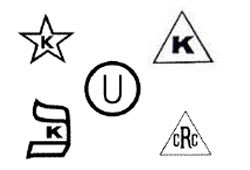Understanding kosher food labels can be confusing, especially with the symbols and terms used. This guide provides a comprehensive overview of how to identify kosher foods and what the different symbols mean, with a special focus on how kosher labeling interacts with food allergies.
Understanding Kosher Categories
Kosher dietary laws categorize food into three main groups:
- Meat (Fleishig/Basari): This includes meat and meat derivatives.
- Dairy (Milchig/Chalavi): This includes milk and milk derivatives.
- Pareve (Parve): This includes foods that are neither meat nor dairy. They can be eaten with either meat or dairy dishes.
The key principle of kosher law is the separation of meat and dairy. This separation extends to preparation and consumption, meaning separate utensils and cookware must be used.
Deciphering Kosher Symbols
Kosher certification agencies ensure that food products meet kosher standards. These agencies examine ingredients, supervise preparation processes, and inspect facilities. Products certified kosher display specific symbols, which are registered trademarks. The presence of a symbol indicates that the product adheres to kosher guidelines and identifies the certifying organization.
Here’s a breakdown of common symbols and their meanings:
- Meat: The word “Meat,” the letter “M,” or “Glatt” near the kosher symbol indicates the product contains meat or meat derivatives.
- Dairy: The word “Dairy” or the letter “D” near the kosher symbol signifies the product contains milk or milk derivatives.
- Fish: An “F” printed near the kosher symbol indicates the product contains fish.
- Pareve: The words “Pareve,” “Parev,” or “Parve” near the kosher symbol mean the product is neither meat nor dairy.
Important Note About Passover: A “P” near the kosher symbol doesn’t mean pareve; it means the product is kosher for Passover and all year round. Combinations like “D-P,” “M-P,” or “F-P” indicate dairy, meat, or fish, respectively, and kosher for Passover. Don’t confuse “P” (Passover) with “Pareve”.
Kosher Labels and Food Allergies: What You Need to Know
While kosher labeling can be a helpful cross-reference for individuals with food allergies, it should not be the sole determinant of a food’s safety.
- Kosher dairy labels indicate the presence of dairy ingredients. If a product is labeled “Kosher dairy”, you can assume it’s unsafe for someone with a dairy allergy.
- “D” or “DE” on a Kosher label: A “D” or “DE” might appear after the Kosher symbol if the food was processed on equipment also used for dairy. This means there is a potential risk of cross-contamination.
- Pareve doesn’t guarantee dairy-free: A product labeled “Pareve” might still contain trace levels of dairy due to cross-contamination.
Key Takeaways for Individuals with Food Allergies:
- Never rely solely on kosher labeling to determine if a product is safe. Always read the ingredient statement carefully.
- Kosher labeling doesn’t address cross-contamination issues. Traces of allergens can be present in kosher foods.
- Contact manufacturers to determine a food’s safety if you have any concerns.
In conclusion, understanding kosher symbols and categories is essential for those adhering to Jewish dietary laws. However, individuals with food allergies should use kosher labels as a helpful cross-reference and always prioritize reading ingredient statements and contacting manufacturers to ensure the safety of food products.
